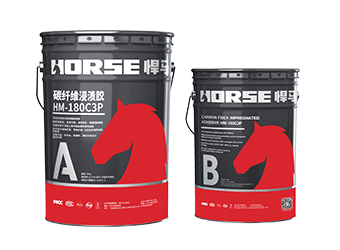Solutions
Horse Construction offers full range of structural strengthening materials with technical supports, documentation supports, products supports, project supports.
Carbon Fiber Strengthening - HORSE Construction
1. Carbon Fiber Strengthening technology introduction
1.1 External carbon fiber strengthening technology
The external pasting method is to polish the reinforced beam body smoothly, and repair the part with cavities with mortar. After cleaning the surface with chemical acetone or alcohol, the surface of the CFRP material is frosted and roughened and coated with a colloidal material to paste on the beam (see Figure 1 ).

1.2 Carbon fiber embedded strengthening technology
The embedded strengthening method needs to cut the embedded groove along the embedded direction in the area of the concrete protective layer, and the entire strengthening process is completed in the beam body. The increase of the contact surface between the fiber and the beam body can be approximately regarded as the overall force system of the two forces, the strengthening effect is better, and the fiber is not easy to peel off (see Figure 2).

1.3 Carbon fiber cloth wrapping strengthening technology
Carbon fiber cloth strengthening requires applying reinforcing glue on the damaged surface of the concrete, and wrapping the fiber cloth on the outside of the structure along the cross section. Since carbon fiber is a one-way tensile material, carbon fiber cloth wrapping strengthening needs to be along the tensile direction of the structure. The package can be pasted vertically or diagonally, or combined with other strengthening methods (see Figure 3).

2 Comparative analysis of carbon fiber strengthening technology
2.1 Comparison of technical requirements
The difference between carbon fiber embedded strengthening and external sticking method is that embedded strengthening requires cutting the embedded groove in the concrete protective layer area along the embedded direction. Clean the lime and waste residue from the wall of the tank, pour epoxy resin into the tank and fill half of the tank, then submerge the CFRP and use tape to fix the position and fill the whole tank and smooth it, and wait until the glue layer is solidified and reinforced.
Compared with the external pasting method, the carbon fiber cloth wrapping strengthening is different in the arrangement of the carbon fiber cloth and the position of the force. Generally speaking, the carbon fiber cloth is stressed after the concrete is stressed. The unidirectional force characteristic makes the carbon fiber cloth more limited than the external strengthening when it is reinforced. From the perspective of use, the carbon fiber cloth can choose multi-layer strengthening, that is, the outer side of the wrapped carbon fiber cloth can be wrapped and reinforced again. In order to ensure the strengthening performance, it is necessary to ensure good permeability and cohesiveness of the adhesive between the strengthening layers. At the same time, the overlap length is required to be more than 100mm.
2.2 Comparison of technical advantages
2.2.1 The advantages of CFRP external bonding method compared with other strengthening methods:
1) The CFRP material has high strength and relatively light weight, which is convenient for transportation and installation, and reduces the structural load.
2) It has a wide range of applications, strong plasticity, and can be made into various types of materials to fit different surface layers. It is suitable for various building structures, bridges (main body or parts), and has a good strengthening effect.
3) The strengthening efficiency is high, the deflection of the reinforced beam body is reduced and the load-bearing capacity is greatly improved, and the strengthening quality is more reliable, and the protection and safety are also higher.
4) The construction process of CFRP material is simple, does not require complicated equipment, the construction period is short, and the forming is fast.
2.2.2 The CFRP embedded strengthening method has many advantages compared to the CFRP external attachment method, which are summarized as follows:
1) The CFRP material is wrapped in the colloid to isolate the contact of air, water, corrosive substances, and flammable substances, reduce the disadvantages of poor fire resistance, and effectively protect the working performance of the CFRP material.
2) The contact area of CFRP material with colloid and concrete is larger, the force transmission is more coordinated, the utilization rate of CFRP material becomes higher, and the material performance can be fully utilized
3) The CFRP material embedded in the structure is less likely to fall off and peel off than the external paste, and the carrying capacity is improved more
2.2.3 Advantages of carbon fiber cloth wrapping strengthening technology:
1) CFRP has better flexibility and can be used in a wider range of structures, and it is flexible to repair and cut according to the requirements of the site
2) Compared with the sheet structure, the carbon fiber cloth can be densely pasted, and the wrapping range can effectively protect the internal concrete from external erosion.
3) Compared with other materials, the unidirectional tensile strength of carbon fiber cloth can be higher, and it can provide more protection for the concentrated load. It can be pasted in multiple layers, and pasted to strengthen the bridge components can greatly improve the bending and shear resistance of the beams and plates, and can significantly improve the stiffness and ductility of the bridge components (such as suppressing cracking, reducing deflection, etc.)
You can find anything here you are in need of, have a trust trying on these products, you will find the big difference after that.

High strength, unidirectional carbon fiber wrap pre-saturated to form a carbon fiber reinforced polymer (CFRP) wrap used to strengthen structural concrete elements.

Good impregnation carbon fiber adhesive for applying carbon fiber reinforced polymer(CFRP) wrap for structural strengthening

High strength carbon fiber reinforced polymer (CFRP) strip / laminate / plate for structural strengthening and concrete repair